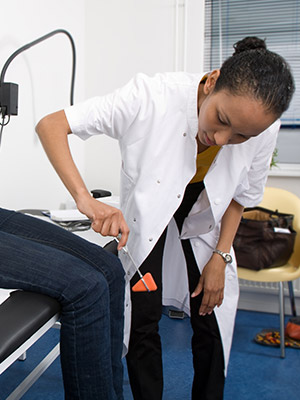 The physicians and staff at the UC Health Pain Medicine Center are fully equipped to treat a variety of pain conditions. Our physicians are nationally renowned and fellowship trained experts in pain medicine, and as faculty members at the University of Cincinnati College of Medicine, are backed by the latest in discovery-driven care and research specific to pain management.
The physicians and staff at the UC Health Pain Medicine Center are fully equipped to treat a variety of pain conditions. Our physicians are nationally renowned and fellowship trained experts in pain medicine, and as faculty members at the University of Cincinnati College of Medicine, are backed by the latest in discovery-driven care and research specific to pain management.
We can provide relief from a wide variety of conditions that cause discomfort.
Musculoskeletal Pain Conditions
Musculoskeletal pain affects the muscles, ligaments, tendons and bones and can be either acute or chronic.
- Back and neck pain. Pain in the back or neck can range from mild, dull pain to severe, debilitating pain. Such pain can also come on suddenly (acute) or last for weeks or months (chronic), often fluctuating in intensity.
- Failed back surgery pain. Also known as failed back surgery syndrome or post-laminectomy syndrome, this condition occurs when a patient has undergone a previous back surgery, either as a result of injury or to reduce pain, and continues to experiences chronic pain post-surgery.
- Joint and muscle pain. Causes of pain in the joints can range from acute events to normal wear and tear. These can lead to degenerative changes — from aging to arthritis. Strains or sprains also cause pain in the muscles.
- Sciatica. Also known as lumbar radiculopathy, this pain originates from the low back and is referred into the legs. It can range from lower back pain to numbness, or shooting pain in the lower extremities.
- Cervical Radiculopathy. This is referred pain from the neck which goes into the arms. It can range from focal neck pain to numbness and shooting into the upper extremities.
- Osteoarthritis. A type of arthritis that occurs when the flexible tissue at the ends of bones wears down, osteoarthritis is the most common type of arthritis. It can affect any joint in the body, but most frequently affects the hands, knees, hips and spine.
Neuropathic Pain Conditions
Neuropathic pain is caused by damaged or dysfunctional nerves, resulting in pain, and can be the result of several conditions.
- Complex regional pain syndrome (CRPS) / Reflex Sympathetic Dystrophy (RDS). In this debilitating condition, the patient experiences severe swelling, pain and skin changes throughout the body that can worsen over time. This condition can lead to irreversible skin and bone changes, in which the limbs become atrophied (broken down) over time. This condition was previously known as reflux sympathetic dystrophy (RSD).
- Peripheral Neuropathy (Diabetic Peripheral Neuropathy). Peripheral neuropathy is a major cause of pain in the upper and lower extremities. There are multiple causes, including diabetes, HIV and chemotherapy which have affected the nerves in their extremities. This condition can cause a burning sensation and pain in the feet, legs, hands and arms.
- This condition is a complication caused by the chicken pox virus. While shingles outbreaks usually clear up within a few weeks, in some rare cases the pain can last long after the rash and blisters have disappeared. This pain, called post-herpetic neuralgia, continues after a shingles outbreak.
Facial or Head Pain Conditions
- Dental pain. Temporomandibular joint disorders and other dental pain can occur as a result of problems with the jaw, jaw joint and surrounding facial muscles.
- Headaches. Highly variable in location, intensity and frequency, a headache is pain or discomfort in the head or face. Such pain has a wide variety of causes, which may involve nerves, muscles or blood vessels. The UC Health Pain Center is part of the Headache and Facial Pain Program at the UC Health Neuroscience Institute.
Abdominal or Pelvic Pain Conditions
- Pancreatic pain. Caused by inflammation of the pancreas, people can experience pain from either acute or chronic pancreatitis. Pain due to acute or chronic pancreatitis can range from a mild discomfort to a severe, debilitating pain.
- Pelvic pain. Pain in the pelvic area can be caused by a number of underlying conditions and can range from mild discomfort to severe, debilitating pain.
Work-Related or Sports-Related Accidents
- Sports-related accidents. Accidents that occur while exercising or playing sports are extremely common, and many result in injuries. These injuries, which include sprains, strains and fractures to the muscles, ligaments and bones throughout the body, can cause pain that can become chronic.
- Work-related accidents. The workplace is a common source of injury, especially in active roles, and these injuries can cause pain that results in missing work.
Other Pain Conditions
- Cancer-related pain. Pain due to cancer and cancer treatment can manifest itself in any organ or part of the body that is affected by cancer. Effective pain management during active cancer treatment can help the patient to be more comfortable and able to receive the needed cancer treatment.
- Fibromyalgia. This condition is a chronic, widespread pain in the soft tissue and muscles surrounding the joints, often throughout the body. Fibromyalgia is fairly common—2% to 4% percent of the U.S. population—with mostly middle-aged women being affected.
